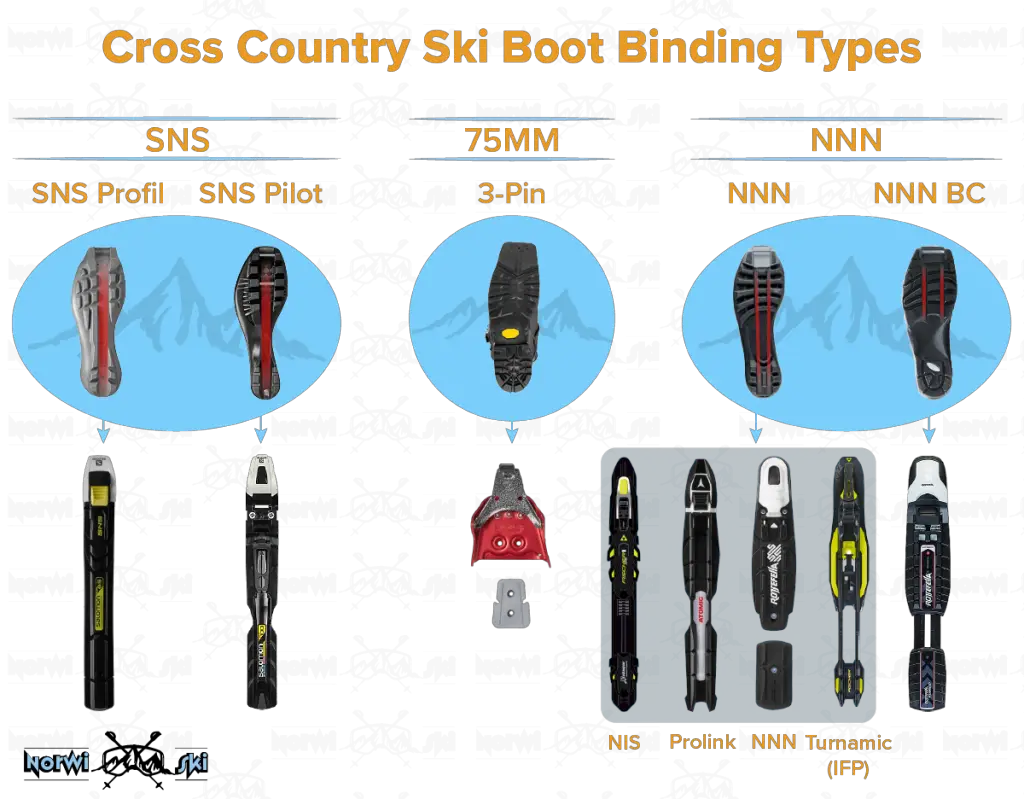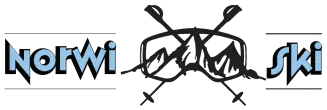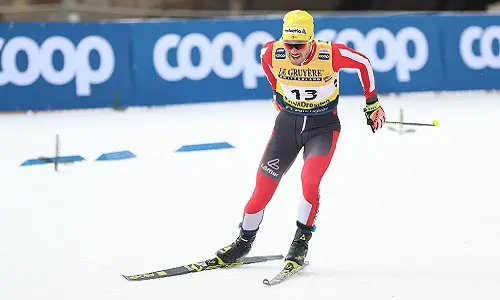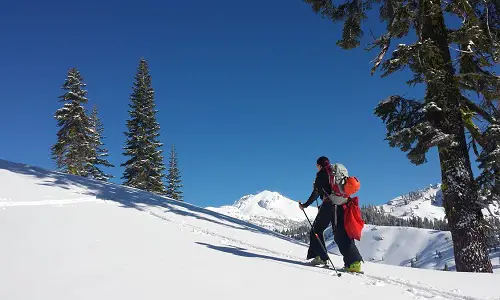Table of Contents
Your preference for a XC ski binding mainly depends upon the choice of your cross country ski boots, the type of skiing you prefer, as well as the terrain you will be skiing on. It helps immensely if you select the right kind of cross country ski bindings for your ski trip.
The most popular type of cross-country ski bindings is considered to be the NNN ski bindings. This is the reason why it is used in most of the rental skis in ski touring centers. Even the SNS-producer Salomon came up with an NNN compatible binding, the Prolink.
Types and Differences of Cross-Country Ski Bindings
Since there are different types of XC ski binding available, how do we know which one is the perfect match for us? How do we know which binding system does a ski boot work with? The answer is simple. If you have a pair of ski boots and are not sure about their binding system, glance at the sole of the boot.
If you find two shallow and thin grooves that run from one end of the sole (length-wise) to the other, you have a NNN ski boot. It is one of the most commonly used types of ski bindings.
If there are two bars on the sole, you have a current SNS or Pilot boot. If the center of your ski boot has a single wide and deep bar running across the sole length-wise, you have an old SNS or Profil Boot.

Most of the cross country skis that you find these days come with a plate that lets you install a binding that you can slide. The advantage of having such slide-on bindings is that there are not permanent as you can take them on and off as per your choice. Moreover, they are mostly adjustable, that is, you can adjust these bindings to move forward or back on your ski.
Types of Cross-Country Ski Bindings
There are two types of bindings that can be drilled in.
- Automatic binding
- Manual binding
You can step in an automatic binding, and for release, you need to press your cross country ski poles onto a button present on the binding. In case of a manual binding, you need to open it manually (as the name suggests) by lifting a lever by your hands. You can then step in it and then manually close it. You will have to follow the same steps to release the bindings.
If your Nordic skis do not have any plate, you must go for a drill-in binding. In the case of NNN, you can select a Salomon Prolink binding. It is up to you whether you want to go for an automatic Prolink Auto or a manual Prolink Access binding.
In the case of Profil Boots, you can select the Salomon Profil Auto Universal Bindings – which as the name indicates, is an automatic ski binding.
If you have Pilot Boots, you have the option to choose between the automatic Salomon Profil Auto Universal or the manual Salomon Pilot Sport Classic binding.
If your ski has a single black plate (NIS plate), you can install a Rottefella Touring Automatic Binding. On the other hand, there is another type of plate known as the IFP. If your ski has two black plates that have a colored plastic with 3 holes at the plate on the top, you can install and use the Turnamic Binding.
Both the NIS as well as the IFP plates are only compatible with the NNN bindings. If you want, you can drill the SNS binding through a plate, but you will need to get an adaptor plate for the IFP bindings.

NNN Binding
The New Nordic Norm binding or the NNN binding is quite famous among skiers all over the world. There are many versions of the NNN binding system. The first NNN binding is not compatible with the current designs of NNN systems, however, two main binding systems are still very popular:
- The NNN binding, and
- The NNN BC binding
The NNN and NNN BC belong to the same family of bindings and are most commonly used in most of the ski touring centers. In these bindings, the pivot bar is near the toe of your ski boot, helping you to see where to align it with the binding clip. The NNN BC ( New Nordic Norm Backcountry) is a much stronger version specially designed for Backcountry.
SNS Binding
The Salomon Nordic System SNS comes in two different options:
- The SNS Profil bindings, and
- The SNS Pilot bindings.
SNS Profil Binding
The SNS Profil bindings work similarly to the NNN and NNN BC binding. Since the pivot point of the SNS Profil bindings is very close to the toe, you can easily see what you are doing and hence is easier to use.
SNS Pilot Binding
The SNS Pilot bindings were originally designed for ski racers but are also great if you want to try skate skiing. What differentiates these bindings with others is that they have two pivot bars on the boots, and clipping onto these bindings offer extra control, making them a great choice for skate skis. One pivot bar is at the rear while the other is at the front. The pivot bar at the rear helps guide the skier, whereas the front pivot bar aligns with the clip.
The SNS Pilot bindings are easy to step into, which is a big plus in cross-country skiing. All you need to do is to do a gentle press on the forefoot and the binding is successfully snapped on.
Prolink Binding
The Salomon Nordic System has multiple options for ski bindings. However, with the popularity of NNN bindings, Salomon introduced its NNN boot system known as Prolink. Although Salomon asserts that their SNS bindings will still have a future as Salomon will keep on producing them to make the bindings available for skiers, there is no denying the fact NNN binding has been a favorite among skiers.
For this reason, Prolink bindings were launched as a better product – that’s what they claim. The Prolink bindings are relatively lighter than their NNN counterparts. The Prolink binding claims to have better snow feel as compared to not only NNN bindings but also their own SNS bindings (as they pair with boots with thick soles).
Also, the bindings can be mounted onto the ski using pre-drilled holes – unlike the IFP or NIS plates used by NNN.
Turnamic Binding
These bindings work on IFP binding plates – the Integrated Fixation Plates. IFP plates are basically two black plates with one plate having 3 holes in it. You can find these holes on a colored plastic piece on the top plate. On these types of plates, you can install your Turnamic bindings.
IFP Bindings
The IFP binding plate enables you to use a tool-less adjusting system of binding position. The Turnamic binding uses a step-in locking mechanism for your ski boots. You can turn the lever to the sides to open or close the lock.
You can use the IFP’s Turnamic bindings with all NNN as well as Prolink ski boots. However, due to the new lock system, you cannot adjust the NIS 1.0 bindings on the IFP plate.
Compatibility Guide
There are five main kinds of XC ski boot soles. All these soles have a corresponding binding.
- 75 mm (3 pin boots)
- NNN boots
- NNN BC boots
- SNS Profil boots
- SNS Pilot boots
| Type of Ski Boots | Bindings that are compatible with these boots |
| NNN boots | NNN bindings, NIS bindings, Prolink bindings, and Turnamic bindings |
| NNN BC boots | NNN BC bindings |
| 3 pin boots | 75 mm (3 pin) bindings |
| SNS Profil boots | SNS Profil bindings |
| SNS Pilot boots | SNS Pilot bindings |

Conclusion
It is important to know all the available kinds of XC ski binding before making the final choice of purchasing one. Your binding is a crucial part of your cross-country skiing gear as it connects your ski boots with the skis, holding your ski boots strongly so you can maneuver the ski and feel complete in-control. Not only that, but it also tends to minimize an injury by releasing your ski boot in the case of a ski accident.
Before finalizing your XC ski bindings, make sure you know the ski boots you have or are planning to have, your skis, as well as the snowy terrain you plan to ski on. Once you have the right ski bindings for your ski along with your XC ski gear, the sky is the limit – or should I say gliding on the slopes could be limitless!


